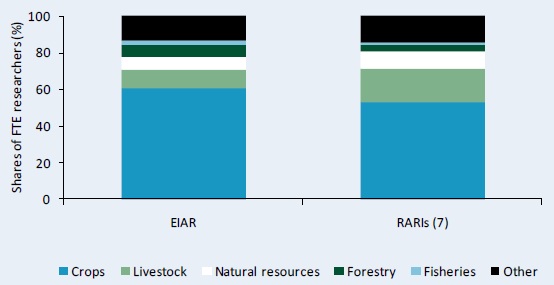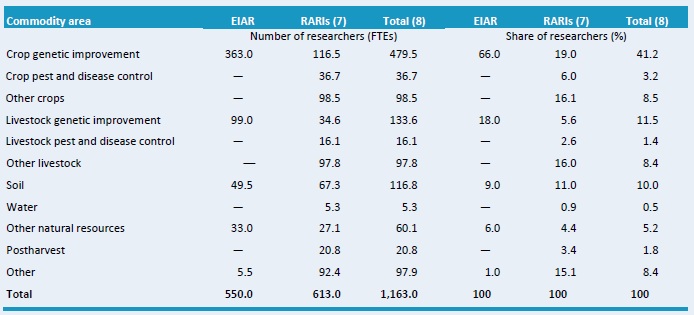The ASTI Data in Focus series provides additional background data in support of the 2010 Country Note on Ethiopia (asti.cgiar.org/pdf/Ethiopia-Note.pdf) prepared by the Agricultural Science and Technology Indicators (ASTI) initiative and the Ethiopian Institute of Agricultural Research (EIAR). Based on data collected by ASTI and EIAR, these two outputs review major investment and capacity trends in Ethiopian public agricultural research and development (R&D) since 1971, providing important updates on agricultural R&D trends prepared by ASTI and EIAR in 2003–04.
D. Research Allocation across Commodities and Themes
This section provides detailed quantitative information on Ethiopian public agricultural research allocation for 2008. Complementary sections present detailed data on long-term trends (Section A), financial resources (Section B), and human resources (Section C). Further supporting information provides macroeconomic trends, a list of agencies included in the study, data sources and estimation procedures, and ASTI's methodology.
Table D1–Research focus by major commodity area, 2008
This table presents full-time equivalent (FTEs) researcher numbers by major commodity area both in absolute and relative terms. In 2008, the largest number of researchers (661 FTEs) focused on crop research. Of the remaining researchers, 166 FTEs focused on livestock, 96 on natural resources, 55 on forestry research, and 26 on fisheries research. The other 161 researchers concentrated their efforts on socioeconomic research, agricultural engineering, or other matters.

Source: Calculated by authors from ASTI–EIAR 2009–10.
Notes: Figures in parentheses indicate the number of agencies in each category. Research focus data were not available for the higher education agencies.
Figure D1–Research focus by major commodity area, 2008
Crop research dominated the focus of agricultural research in Ethiopia, accounting for 61 percent of all FTE researchers employed at EIAR and 53 percent of those at the regional agricultural research institutes (RARIs) in 2008. Comparatively more researchers focused on livestock at the RARIs (18 percent) than at the Ethiopian Institute of Agricultural Research (EIAR) (10 percent). At EIAR, 7 percent of researchers focused on natural resources, 6 percent focused on forestry, and 3 percent focused on fisheries. At the RARIs, 9 percent of researchers focused on natural resources, 3 percent focused on forestry, and 2 percent focused on fisheries.

Source: Calculated by authors from ASTI–EIAR 2009–10.
Notes: Figures in parentheses indicate the number of agencies in each category. Research focus data were not available for the higher education agencies.
Table D2–Focus of crop and livestock research by major item, 2008
In 2008, the most researched crop in Ethiopia–employing 126 FTE researchers and representing 13 percent of total (combined) crop and livestock research, was wheat. Other important crops were maize (7 percent); sorghum, vegetables, barley, and potatoes (5 percent each); and coffee (4 percent). The country's livestock researchers primarily concentrated on dairy, sheep and goats, and beef. RARIs conducted research into a variety of commodities. All of these agencies except the Somali Region Pastoral and Agro-Pastoral Research Institute (SoRPARI) reported conducting research on at least 10 different commodities in 2008. The Gambela Agricultural Research Institute (GARI) allocated the largest share of researchers to a single crop (26 percent to maize).

Source: Calculated by authors from ASTI–EIAR 2009–10.
Notes: Figures in parentheses indicate the number of agencies in each category. Research focus data were not available for the higher education agencies.
Table D3–Focus of crop and livestock research by major theme, 2008
This table shows FTE researchers by thematic area in absolute and relative terms. Crop genetic improvement is an important research theme in Ethiopia, accounting for 480 of the 1,163 FTE researchers (41 percent) employed at EIAR and the RARIs in 2008 combined. Livestock genetic improvement and soils were other important thematic areas of research, accounting for 12 and 10 percent of the agricultural researchers at the eight agencies, respectively. Large variations were, however, reported across agencies: for example, 25 percent of researchers at the Amhara Regional Agricultural Research Institute (ARARI) focused on natural resources research, whereas only 2 percent of researchers at Afar Pastoral and Agro-Pastoral Research Institute (APARI) worked in this area.

Source: Calculated by authors from ASTI–EIAR 2009–10.
Notes: Figures in parentheses indicate the number of agencies in each category. Research focus data were not available for the higher education agencies.
Copyright (C) 2011 International Food Policy Research Institute and Ethiopian Institute of Agricultural Research. Sections of this Data in Focus issue may be reproduced without the express permission of, but with acknowledgment to, IFPRI and EIAR. The Data in Focus series is an output of the ASTI initiative and has not been peer reviewed. Any opinions stated herein are those of ASTI and do not necessarily reflect the policies and opinions of IFPRI or EIAR.
